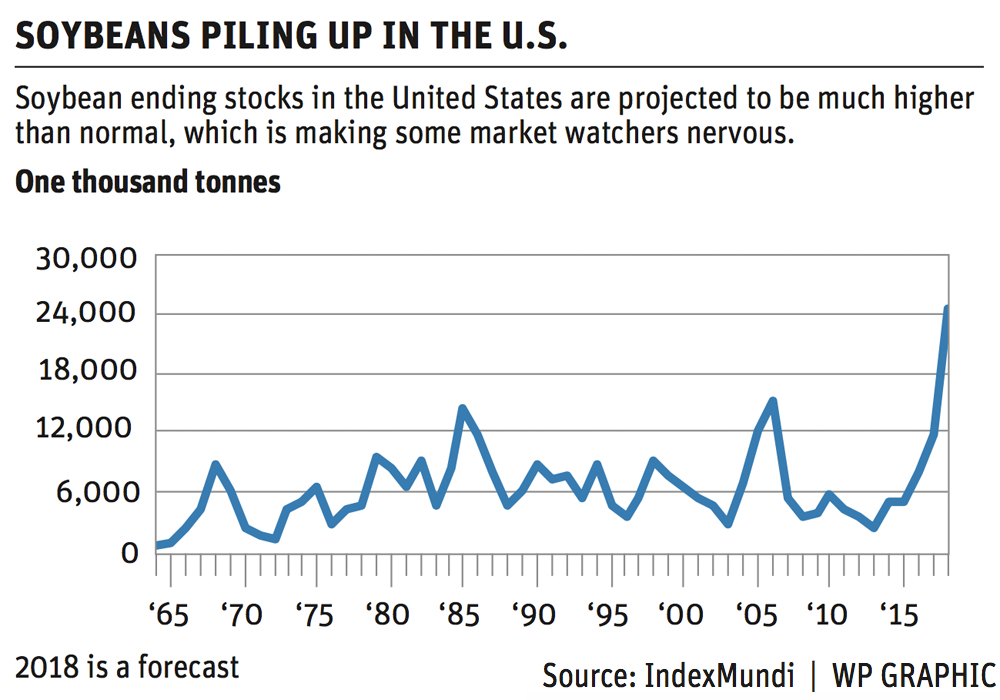Soybean prices are set to tumble and that will drag down corn and other grain prices, says an economist.
The nearby soybean futures price at the end of last week was about US$9 per bushel. That is up almost $1 per bushel from harvest lows.
That is despite the United States Department of Agriculture forecasting a staggering 24.76 million tonnes of U.S. soybean ending stocks. The previous record was 15.6 million tonnes in 2006.
“I’ll be honest with you, it’s a bit of a head-scratcher to me,” said Todd Hubbs, agricultural economist with the University of Illinois.
Read Also

New coal mine proposal met with old concerns
A smaller version of the previously rejected Grassy Mountain coal mine project in Crowsnest Pass is back on the table, and the Livingstone Landowners Group continues to voice concerns about the environmental risks.
He believes soybean prices are overblown and due for a big correction.
“I’m concerned. I’ll tell you that.”
The economist believes prices could plummet as low as $8 per bu. by March unless there is a further reduction in Brazil’s crop or the U.S. inks a trade deal with China.
“Things can get bad. They can get really bad,” he said.
Rich Nelson, chief strategist with Allendale Inc., said anybody using a stocks-to-use model knows soybean prices are artificially inflated.
But he doesn’t share Hubbs’ forecast for a nearby price collapse.
“As far as the next month or two I don’t hold that same pessimism,” he said.
Allendale believes the November futures price will hit $8 per bu. by this fall. But in the short-term, psychology is trumping fundamentals and that is bolstering soybean prices.
The market believes Brazil’s crop will end up well below the USDA’s 117 million tonne estimate. Most in the trade are forecasting 112 to 115 million tonnes.
Prices are also being propped up by positive vibes surrounding the U.S. and China trade negotiations.
The market seems to think a deal will get done and China will buy copious amounts of U.S. soybeans in the second half of the 2018-19 campaign.
But Hubbs said those two factors are big unknowns.
“Prices right now are really untenable if we don’t get a trade deal or there isn’t a significant production shortfall in South America,” he said.
It is unclear whether the U.S. will be able to hash out a trade deal with China in time to put a big dent in bloated U.S. soybean supplies.
“If we don’t start exporting, and I mean soon, that ending stocks number is going to grow,” said Hubbs.
Even if there is a deal he doubts China will buy as many soybeans as the market anticipates.
The third key factor that will determine when and how far soybean prices fall is the USDA’s March Prospective Plantings report.
Industry analysts forecast 2019 soybean plantings in the range of 84.5 to 86.5 million acres, which would be well below last year’s 89.1 million acres.
Hubbs suspects it could come in well above those levels because growers are unimpressed with lacklustre corn prices.
Soybean prices look attractive by comparison, especially given there is no nitrogen fertilizer expense for growing the crop.
“If we do more than (85.7 million acres) the world is going to be awash in beans. It really is,” he said.
Nelson doesn’t believe soybean acres will surprise to the upside.
Since July 2018, much of the western corn belt has received 250 to 500 millimetres more rain than usual.
“We do have a saturated situation,” he said.
In other years with similar moisture conditions about four to eight million acres goes unseeded in the corn belt compared to the usual two million acres.
Hubbs is worried what will happen in March if it looks like Brazil will indeed harvest a 117 million tonne crop, there is no trade deal with China and growers don’t cut back on soybean acres as much as the market anticipates.
“You’re going to see some serious price weakness in beans,” he said.
“I think that will be all she wrote this year.”


















